ARCHITECTURE OF INVOLVEMENT
By Andrew Maerkle
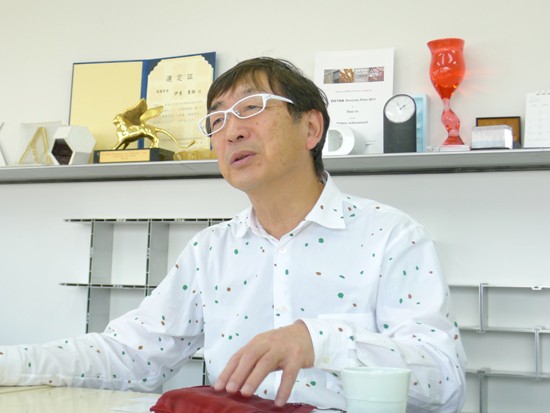 Toyo Ito at his offices in Tokyo, March 2011. Photo ART iT.
Toyo Ito at his offices in Tokyo, March 2011. Photo ART iT.Through designs for projects including the Sendai Mediatheque, Tama Art University Library (Hachioji Campus) and Taichung Metropolitan Opera House, Toyo Ito expresses a visionary architectural language that addresses structure in terms of flow and continuum rather than opposition and containment. An articulate, critical thinker on architectural issues in contemporary society, Ito has also been a mentor to successive generations of emerging architects, including Kazuyo Sejima and Ryue Nishizawa of the firm SANAA. Ever concerned for the future of architectural innovation, Ito is now investing significant time and energy into establishing a new educational initiative through the NPO Initiative for Tomorrow’s Opportunities in Architecture (ITO). Launching May 21 in Tokyo’s Kamiyacho neighborhood, ITO School will comprise an intensive seminar for emerging architects, a program dedicated to primary- and secondary-school-aged children, and a bi-monthly series of “Saturday Lectures” for the general public. Ito plans to be an active presence in all of the school’s programs.
On March 9, ART iT met with Ito to ask him about his ideas on architecture and education. The interview was conducted less than 48 hours before the Tohoku Pacific Earthquake and Tsunami devastated the northeastern coastline of mainland Japan, including the city of Sendai. Discussing the Mediatheque as a profound learning experience, Ito expressed his admiration for the people of Sendai and what they showed him about the possibilities for an architecture of the 21st century. Regardless of its ultimate fate, in its current situation the Mediatheque now becomes an all-too poignant, irrefutable reflection of Ito’s guiding ethos that it is the people who make the building, and not the other way around.
Contents:
Interview: Discussion as an Ecological Unit of Thinking
Text: Message for those affected by the Tohoku Pacific Earthquake and Tsunami
Discussion as an Ecological Unit of Thinking
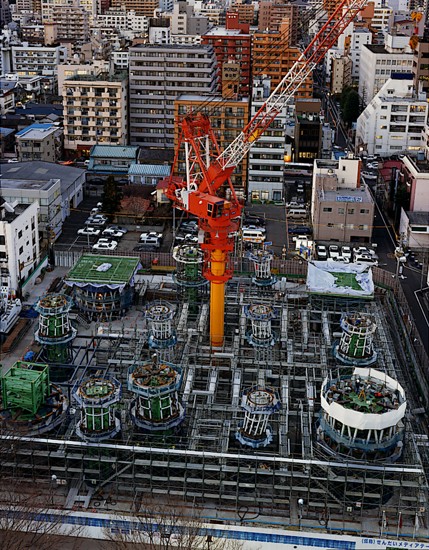 Naoya Hatakeyama – sendai mediatheque, from “Under Construction” (1998-2001).
Naoya Hatakeyama – sendai mediatheque, from “Under Construction” (1998-2001).All images: Courtesy the artist and Toyo Ito & Associates, Architects.
ART iT: You are currently working toward establishing your own private architecture school with programs for both emerging architects and primary- and secondary-school-aged children as well as the general public. Can you explain more about your approach to establishing such a school and the role of education in architecture?
TI: As an educator, I myself only have experience as a guest professor and part-time lecturer at university, in part because I feel that the current university curriculum is not adequate for teaching architectural design. For some time now I have felt the need to establish a small-scale private school or seminar for architecture. Currently in many architecture programs at Japanese universities the professors are not necessarily architects. In fact, many of them are researchers. To me this calls into doubt the very premise that students are learning how to realize actual buildings. Another problem – not limited to Japan – is that the current architecture curriculum is fundamentally rooted in Modernist architectural principles, whereas the architecture that I am working on in my practice is one step beyond Modernism. The 20th-century educational system no longer reflects the current age. The impetus behind the school is my search for an alternative way to think about architecture together with young people.
ART iT: In the course you are planning for emerging architects, how do you see the balance of emphasis between practice and theory?
TI: Naturally in an educational context we are limited in terms of what we can actually practice, but there is a substantial difference between thinking about architecture as something that will be built and investigating the nature of architecture in only theoretical terms. Through my school I hope to put forward a set of principles for a potential 21st-century architecture. I feel that the principles of 20th-century architecture did not fully account for people – everything was very abstracted. This led to the industrialization and commercialization of architecture. To put it differently, architecture came to be thought of in a way similar to abstract painting. But my concern is not with abstraction and rather with what an architecture that is truly made for its users might look like, and how architecture can be produced through particular social systems.
ART iT: As a proposal for a “non-Modernist” architectural education, how do you see your curriculum escaping Modernist principles, or is that even possible in practical terms?
TI: In my office we are partly working from within Modernist paradigms and partly already beyond Modernism. Our designs for the buildings we make emerge from this kind of hybrid condition. But I honestly wonder whether there isn’t a way to move more definitively beyond Modernism. One aspect of my planned curriculum is the program of general lectures that address architecture through the consideration of actions that are not directly tied to architecture, like primitive body movements, or wearing clothing, or eating, or even reading a book or writing a novel. I will invite artists, writers and chefs to participate in these lectures, and discuss with them the overlaps between the concerns of their professions and those of architecture.
For the emerging architects’ program, I plan to look closer at the concept of the “ecological unit,” which my staff and I first conceived for an exhibition project as a unit of space on the scale just between architecture and urban space. We will be thinking about how people should live at such a scale, or rather what kind of ecological environments are possible at that scale. My idea for the course is that we will consult a range of specialists, conduct our own research and then even go so far as to produce a design together.
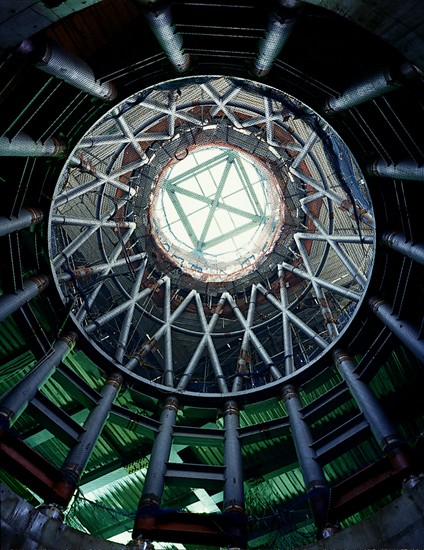 Naoya Hatakeyama – sendai mediatheque, from “Under Construction” (1998-2001).
Naoya Hatakeyama – sendai mediatheque, from “Under Construction” (1998-2001).ART iT: The rise of Modernism brought about the systemization of education as we currently know it. And within that system, students generally elect a specialty, learn the fundamentals of their chosen field, graduate and then enter the workforce. Do you feel that the small-scale school or private seminar is a necessary alternative to that structure?
TI: We are already living in a society that has been produced through modernist ideology, which permeates our administrative and economic systems. It is extremely difficult to find a space to think about things from a distance. As such, I feel it is impossible to begin anything other than on a private, small scale. For example, in the architecture that is currently being built the concept of function is not actually so important. Yet almost every architectural competition or project begins with a stated function, and thinking about how to structure that function. I believe that in our current society scaling back “functionality” could possibly provide more freedom and enjoyment for a building’s users to explore the architecture on their own. Try teaching this at university, though, and because all the professors hold fast to their specialties the architectural concepts get Balkanized. The small-scale approach allows for a degree of autonomy from that system and more freedom for innovation.
ART iT: The division of specialties among a university faculty in a sense parallels the role of function in determining architectural design. And of course the whole structure of a university is divided into units, which makes it difficult to work independently or generate flows between different fields of knowledge, whereas perhaps the interesting possibility of the private seminar model is that it does away with the concept of the unit altogether.
TI: There are of course many excellent professors at university, but viewed from the outside they seem to be entrenched in a system that prevents them from fully exercising their responsibilities. If you are going to construct an actual building there are necessarily economic factors involved, but you won’t find anybody at university teaching about how to deal with money even though it’s such an obvious part of the process. Even the most outstanding young architects who join my staff are oblivious to this financial aspect, as well as to zoning restrictions. They only have eyes for concepts, and it’s mystifying when you try to unpack what those concepts really mean. Breaking down those blinders is one of the major goals that I have for this school.
ART iT: We recently conducted an interview with Ryue Nishizawa in which he said something to the effect that when he was an intern at your office he learned more about architecture than what had been taught to him at university. One thing in particular he noted about your office was that whereas university lectures stressed “scientific” solutions to predictable problems, you maintained a subjective approach, asking each member of your staff for input. How conscientiously do you engage in instruction at your office?
TI: Certainly working on designs together with my staff is a kind of instructional activity. We are organized into teams, and even the youngest architects and I are all on approximately the same level when it comes to putting forward ideas. We might pick someone’s idea, study it, and repeat the process with another idea. This process might be considered a form of instruction, although I have no intent for it to be so, and there is no luxury of time for anything more involved. The gap between the daily work of designing in the office and the abstracted approach to thinking about architecture at university is so wide that I felt organizing a private seminar could provide a bridge between the two extremes.
ART iT: Kazuyo Sejima and Nishizawa from SANAA as well as younger architects like Sou Fujimoto have all cited you as a major influence. Do you think it’s possible to identify an “Ito School” of architects working in Japan today?
TI: I think we all have significant differences. I am a supporter of everyone you mention, but I feel their thinking is becoming too abstract, and losing sight of the role of the architect in society. I recently participated in a discussion event with Fujimoto, where I told him that although his concepts are extremely lucid and address new, contemporary issues, the one problem I have is that his architecture strikes me as being all about models rather than realization. My critique is that it needs to go through another level of revision before it can become real architecture. When presented through a model, a concept might appear lucid, but there are numerous underlying tensions involved when you try to establish those ideas in actual society, and perhaps Fujimoto has yet to fully experience that. For me grappling with that divide is the most interesting aspect of architecture; it is what gives architecture its ultimate significance. Architecture that doesn’t do that becomes indistinguishable from art.
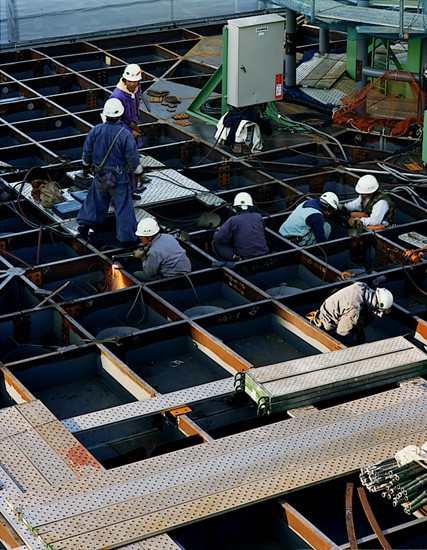 Naoya Hatakeyama – sendai mediatheque, from “Under Construction” (1998-2001).
Naoya Hatakeyama – sendai mediatheque, from “Under Construction” (1998-2001).ART iT: So you feel that art and architecture should be distinct. Was there any specific point in your development as an architect when you realized this?
TI: There was. Designing Sendai Mediatheque (1995-2001) was a tremendous learning experience. Previously I had thought that architecture should have some element of beauty in order to be successful. Unconvinced of my own place in or even relevance to society, the only thing I felt I could do as an architect was to make beautiful buildings. I maintained this attitude even during the Mediatheque competition. However, through my discussions over the course of five or six years of working with general citizens, systems technicians, bureaucrats and all kinds of other people – discussions that I had never had up to that point – I underwent a change in philosophy. I began to see the potential for an architecture that more than being beautiful plays an active role in society; I came to understand my own relevance as an architect to society. Once the Mediatheque opened I felt for the first time that even if you try something new and challenging it’s still possible to create an architecture that can be embraced by the people in a given society. I came to understand the possibility of an architecture that could allow people a freer or more intuitive experience of space than anything that has come before. This was a major revelation.
ART iT: Have you researched previous socially progressive educational initiatives like the Bauhaus or Black Mountain College in designing the curriculum for your own school?
TI: I haven’t particularly looked at those examples in preparing my own curriculum, but given what I already know I find that era to be of great interest. As with art, in the 1920s and ’30s architectural principles underwent radical revision based on the belief that architecture could transform society, which I think is truly admirable. But now we are in an age when art and architecture must take divergent paths. If architecture remains in the realm of art then it will remain at odds with society, and alienated architects will veer further and further into the realm of abstraction. Architects are enjoying unprecedented popularity at museums right now, but I have strong reservations about this trend. Architects belong outside of the museums.
ART iT: In that sense how much do you think architecture can actually shape society?
TI: We need to produce a new rationale for architecture if it is to succeed in contributing to society. The Kumamoto prefectural government is currently sponsoring a commission program for architects to design public projects, Kumamoto Artopolis, with the intent of nurturing emerging talent. With the current economic situation these amount to nothing more than small projects, but for the past four years I have been serving as the Artopolis commissioner. For example, I’ve asked Nishizawa to design a plaza in front of the east exit of Kumamoto station, and Mitsuhiko Sato to design a plaza on the other side of the station. The commissions are decided by competition but limited to vetted candidates in order to concentrate on only the most promising young talent. Part of the plaza project is already completed, and it is so fresh that you could search all of Japan and not find anything like it. Even with such a relatively small project, I feel that the people of Kumamoto are coming to understand the context for this kind of architecture. But in general terms, there is a significant gap between what an architect appreciates and the kind of architecture that people in a regional city like Kumamoto appreciate. One of my constant concerns as commissioner is how to bridge that gap. I feel that Japan is reaching a critical point at which if we do not create a new logic for bringing together both perspectives, architects will not be able to survive in society. To put it emphatically, Japan is now entering an era in which large organizations are plucking up young architects, limiting their possibilities for social engagement, and it would be a travesty if we do not do something about it, all the more so because we have so much potential talent here.
ART iT: If architecture is distinct from art, though, how much do you think architecture can actually communicate with people once it is built?
TI: When Sendai Mediatheque finally opened I was surprised at how simply the building was able to communicate with the people. Driven by curiosity, the people naturally began to explore the building, and amazingly there was almost no gap between the design and the use. For the Mediatheque I kept the concept of function extremely ambiguous. As a result, you would find elderly and young people both sharing the same open space, each doing their own activities, with children running about in between, and everybody could realize how exciting such a space can be. What I came to understand is that functionality is an administrative problem, but for users it really is not that essential.
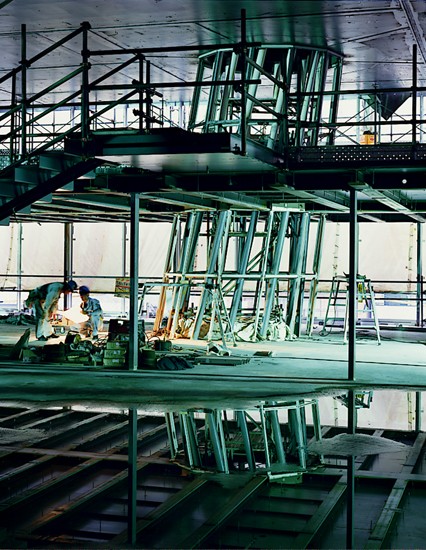 Naoya Hatakeyama – sendai mediatheque, from “Under Construction” (1998-2001).
Naoya Hatakeyama – sendai mediatheque, from “Under Construction” (1998-2001).ART iT: What is interesting is that both architecture and education must also deal with notions of democratic versus authoritarian space.
TI: Certainly – especially at a time when societies across the world are now moved by powerful economic forces, and the most popular architects are riding that wave. For example, once word gets out that Dubai has huge amounts of money, then all the architects gravitate there, as though their only role is to give visible form to excess capital. To an extent there is no way to separate economics and architecture, but if they are unable to find a way to generate an architecture that can communicate with the societies and people for whom they are ultimately working, architects will face extinction. It’s vital that I share this with the students in my seminar, although I’m not sure how far I can push it.
ART iT: Previously you have written about the evolution of architecture in the age of information consumption. Do you feel that education must also evolve under such conditions?
TI: Architecture must accept the fact of its own consumption, but there is almost no mention of this in the Modernist curriculum. I’ve always had a problem with this. Working to establish ITO School with the architecture critic and educator Akira Suzuki, we have designated as one pillar of the program the course for primary- and secondary-school-aged children. How can we teach children about good architecture, and what makes it so? I think it will be extremely challenging to explain to children why something that does not look to them like architecture is actually great architecture. Unless I reorient my own values I won’t be able to tell them what’s good. I am looking forward to coming up with a new language for explaining architecture to them.
ART iT: Is your goal really to teach the children “good” architecture, or is it more about teaching them a way of seeing architecture such that they have the tools to decide for themselves what is good?
TI: Until we actually do the course I can’t really say. My plan is to start by taking the children to residences that have been designed by architects and have them talk about what they see. They will then turn those impressions into drawings that represent what they found to be interesting or strange, which I will respond to with my own commentary. I think that on an instinctual level the children will be sensitive to the architectural elements that haven’t been completely thought through. It will be really meaningful to discuss that with them, and then have them draw out what they think a good house should look like. Maybe there will be children who end up drawing something like the luxury apartments that have come to predominate Japanese society, but whatever they imagine that is unique should be interesting. In that way the course will evolve on a case-by-case basis, although certainly I don’t think it will ever approach anything like formulating a general theory on architecture.
ART iT: On the ITO School website your outlines for the children’s and emerging architects’ courses both mention the composition of urban space. How do you anticipate teaching children about such a complex issue?
TI: The children’s curriculum will have a polar split in content, with the first half focusing on residential architecture and the latter half on the city. For the latter half, I plan on taking everybody for walks in order to look and think about the city and its constituent elements. On these walks I will ask the children to identify their own points of interest, such as a park, or a subway exit, or even a piece of architecture, and then express through drawings or essays why they find these to be interesting, which we will then follow with group discussion. I expect that among 10 or 15 children, each will identify different aspects of the city to research. But in combining all our diverse interests, we can begin to think about how the city is constructed and functions as a system.
ART iT: Regarding the communication between architects and people through the Kumamoto Artopolis project, do you think there are any other means for a more active interaction between the two sides? For example, it seems that if your school is successful then it will give rise to a new generation who are literate in the concerns of urban space and can better articulate their opinions on the future shape of the city – regardless of whether they become architects or not.
TI: That’s really how I feel. And it’s possible that the parents of the children may join in the seminar, so my hope is that starting from a small experiment this has the potential to expand to broader levels.
ART iT: The idea that such an intensive program to nurture emerging architects is necessary in Japan seems at odds with the country’s reputation for producing successive generations of internationally recognized architects. Despite your reservations about the university curriculum, do you feel that the success of Japanese architectural talent has anything to do with the existing social or educational systems here?
TI: I think traditionally Japan has supported and demanded an ability to work with fine details to create beautiful objects – this applies more to the craftsmen and builders than the architects. Compared with my experiences overseas, I am always surprised by the technical proficiency of the Japanese workers, and because this precision is more or less uniform it expands the potential of architectural design. For example, overseas there might be regulations stipulating that concrete walls have to be a minimum of 30cm in thickness, but even though Japan lies upon a seismic belt we are able to make walls that are only 20cm thick, and beautiful as well.
Japanese architects are indebted to this situation. When we work overseas it’s as difficult for us to produce good buildings as it is for anyone else. There are technical restrictions on the usage of materials, and even with design there are limitations in terms of how far one can push things as a foreign architect. In this sense I think that many of the architects in Japan currently enjoying recognition do so because conditions here enable them to quickly build interesting designs. But it’s not like these buildings are necessarily embraced by society. Conversely, it’s because Japanese clients are disinterested in architecture that they will green light any proposal as long as it’s technically sound. Emerging through the cracks, so to speak, these buildings circulate overseas as images and are then praised by international critics for their beauty. In contrast, my experience in Europe has been that designs emerge through a long process of discussion with the clients, and it is such projects that provide me the highest degree of satisfaction once they are completed.
I think Japanese architects are very talented at working on an abstract level – they are able to distill all kinds of information into something that displays a high level of sophistication. What gets left out of the picture are vital concerns like usability and insulation.
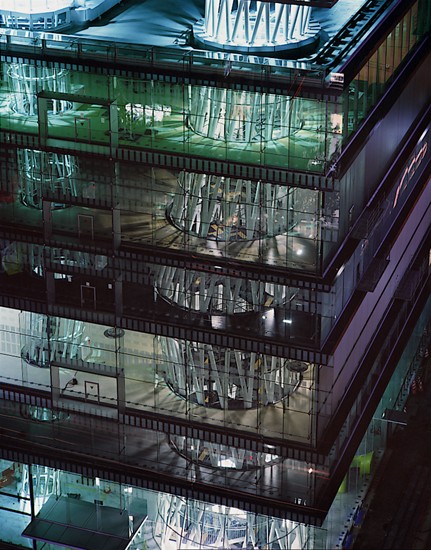 Naoya Hatakeyama – sendai mediatheque, from “Under Construction” (1998-2001).
Naoya Hatakeyama – sendai mediatheque, from “Under Construction” (1998-2001).ART iT: Finally, will you be doing any renovations to the actual Ito School site in Kamiyacho?
TI: The building itself is slated for redevelopment, so we’ve redone the interior of the rented space only at the most basic level. I don’t think it amounts to anything noteworthy. But designing a space for education is certainly something I would like to try in the future.
ITO School launches May 21. For more information, see here (JP only).
Toyo Ito: Architecture of Involvement
